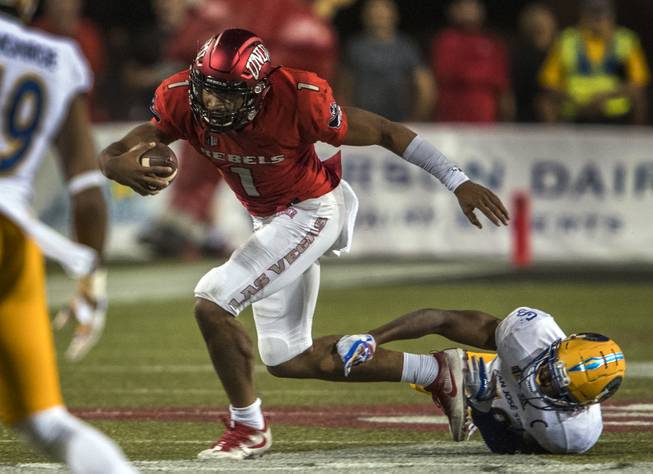
UNLV Rebels quarterback Armani Rogers (1) breaks free from a San Jose State defender and heads towards the goal line in their game on Saturday, September 30, 2017. .
Saturday, Aug. 18, 2018 | 2 a.m.
It feels wrong to blame the UNLV offense for last year’s 5-7 record, as the Rebels averaged 28.8 points per game and topped the 30-point mark six times. But there is still room for improvement on that side of the ball, and one area being emphasized during training camp is the red zone.
UNLV’s offense didn’t exactly struggle inside the opponents’ 20-yard-line last year, but it wasn’t as efficient as it could have been. In 35 trips to the red zone the Rebels scored 19 touchdowns and 11 field goals, with three turnovers and two turnovers on downs.
Head coach Tony Sanchez wants fewer field-goal attempts and more touchdowns in 2018.
“We had one of the top red-zone offenses in the country last year,” Sanchez said, “but when you really look into the numbers I thought we kicked too many field goals down there. We’ve got to do a better job of putting it into the end zone. I know we can do that.”
If the Rebels are to improve their touchdown/field goal ratio, much of it will fall on the shoulders of sophomore quarterback Armani Rogers. He ran the ball effectively around the goal line last year, but when forced to pass in the red zone, he struggled.
Rogers completed 52.4 percent of his passes on the season, but inside the red zone he completed just 6-of-19 on the season (31.6 percent), with three touchdowns and one interception.
Offensive coordinator Barney Cotton said the red zone presents a different challenge when throwing the ball.
“It’s a different type of deal because a lot of times you’re throwing to spots,” Cotton said. “You’ve got front pylon throws, back pylon throws, near goal-post throws, things like that. So you’re not just throwing to guys, you’re throwing to spots and guys have got to get there. And it’s a shorter field, so the same stuff you might do between the 20s, some of that stuff is not available to you in the red zone.”
Rogers’ accuracy has been up and down in training camp, but after struggling in Saturday’s scrimmage he responded with two good days of practice.
“He’s not a real veteran, but he’s a youthful veteran because he’s got nine starts under his belt,” Cotton said. “So hopefully we’re going to get a big improvement because he’s played before. He’s been in the offense. He should be more experienced as far as his leadership ability, which should help us as well. The thing that was good about today was he came out and he had a good day throwing. The other night in the scrimmage was not a real good day throwing the football but he’s got his mojo still, and he’s not going to let a bad day get him down and keep him down.”
Sanchez believes the combination of UNLV’s power running game and Rogers’ passing touch will be the key to cashing in on red-zone opportunities.
“Down there you want to be a physical team,” Sanchez said. “It all starts with physicality. If you can run the ball in the red zone, you’re probably going to be an efficient red zone team. And having a dual-threat quarterback really gives the defense — they have to account for him on every single snap. We want to be physical, but we have to take advantage of them loading the box by just being more efficient in the passing game down there.”
The Rebels can also help themselves in the red zone by cutting down on penalties. They were called for six infractions inside the 20 last year, giving them as many flags as completions on the season.
Cotton said that kind of improvement can only be achieved with more practice reps in training camp and throughout the season.
“We’ve probably spent more time than we ever have down there,” he said. “We were really good last year as far as scoring points, it’s just that we need to score more touchdowns and not as many field goals. So from that standpoint we’re really working hard to try and be ball-secure and get the ball in the end zone.”
Mike Grimala can be reached at 702-948-7844 or [email protected]. Follow Mike on Twitter at twitter.com/mikegrimala.

Join the Discussion:
Check this out for a full explanation of our conversion to the LiveFyre commenting system and instructions on how to sign up for an account.
Full comments policy